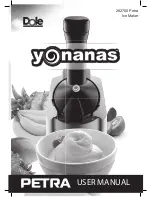
6
storing coffee
31 Coffee is best kept in an airtight container in a cool dry place, or in the fridge.
Exposure to air oxidises coffee and allows the flavour to evaporate.
milk
32 There’s a great deal of contention on the subject of milk in coffee. Our view is that
personal taste should rule, not convention.
33 If you like milk in your coffee, use warm or hot milk, to avoid overcooling the coffee.
34 To extract maximum flavour from the coffee, it should be cool enough not to scald
or burn the mouth, but hot enough to let the flavour fill the mouth, nose and
sinuses, not just the taste buds.
bottled water
35 If you use bottled water, check that there are no added ingredients, flavourings, etc.
and use still water, not sparkling. The carbon dioxide which gives the sparkle will
adversely affect the flavour of your coffee.
taste
36 Don’t be tempted to reheat coffee in the coffee maker. You’ll damage the coffee
maker and the coffee will be undrinkable.
37 Clean the filter holder, filter, and carafe after each use. Residue from a previous brew
will spoil your coffee.
38 If left for much more than about an hour, chemical changes in the coffee liquor start
to affect the flavour. It’s best to pour it away and make a fresh pot.
care and maintenance
39 Unplug the coffee maker and let it cool down fully.
40 Use the grip to open the lid.
41 Use the filter handle to lift out the filter, then tip the used coffee grounds into the
bin.
42 Use the tabs on the filter holder to lift the filter holder out of the coffee maker.
43 Wipe the outer surfaces of the coffee maker with a damp cloth.
44 Wash the filter, filter holder and carafe in warm soapy water, rinse thoroughly and
dry.
45 Replace the filter holder in the coffee maker, with the non-drip valve to the front.
46 Replace the filter in the filter holder.
47 Use the grip to close the coffee maker lid.
48 Replace the carafe on the hotplate.
49 Don’t wash any part in a dishwasher.
50 Don’t put the coffee maker in any liquid.
51 Don’t use harsh or abrasive cleaners or solvents.
descale regularly – even in soft water areas
Limescale
may be white, coloured, even rusty-looking, but it’s normally visible.
Phosphate scale
isn’t generally visible, but it’s there, even in soft water areas.
All scale
causes overheating, and reduces the life of the coffee maker.
So, even with soft water, descale regularly, to help keep your coffee maker in working
order.
Summary of Contents for 14597
Page 1: ...instructions ...
Page 2: ...2 ...


























